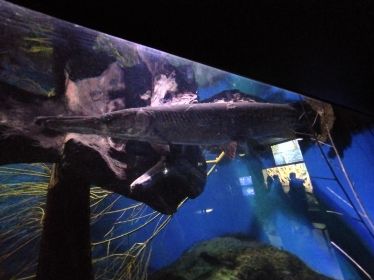- Ground sharks (Carcharhiniformes)
- Carpet sharks (Orectolobiformes)
- Stingrays (Myliobatiformes)
- Skates (Rajiformes)
- Bichir (Polypteriformes)
- Lungfish (Dipnoi)
- Gar (Lepisosteiformes)
- Eel (Anguilliformes)
- Bony-tongued fishes (Osteoglossiformes)
- Carps (Cypriniformes)
- Tetra (Characiformes)
- South American knifefish (Gymnotiformes)
- Catfish (Siluriformes)
- Salmon (Salmonidae)
- Pikes (Esociformes)
- Cod fish (Gadiformes)
- Cardinalfish (Kurtiformes)
- Gobies (Gobiiformes)
- Pipefish (Syngnathiformes)
- Gouramies (Anabantiformes)
- Flatfish (Pleuronectiformes)
- Cichlides (Cichliformes)
- Rainbowfish (Atheriniformes)
- Killifish (Cyprinodontiformes)
- Blenny (Blenniiformes)
- Wrasse (Labriformes)
- Anglerfish (Lophiiformes)
- Pufferfish (Tetraodontiformes)
- Scorpionfish (Scorpaeniformes)
- Ray-finned fish (Perciformes)
- Dragonet (Callionymiformes)
- Weever (Trachiniformes)
Alligator gar (Atractosteus spatula)

The alligator gar (Atractosteus spatula) is a ray-finned euryhaline fish related to the bowfin in the infraclass Holostei. It is the largest species in the gar family, and among the largest freshwater fish in North America. The fossil record traces its group's existence back to the Early Cretaceous over 100 million years ago. Gars are often referred to as "primitive fishes", or "living fossils" because they have retained some morphological characteristics of their early ancestors, such as a spiral valve intestine, which is also common to the digestive system of sharks, and the ability to breathe both air and water. Their common name was derived from their resemblance to the American alligator, particularly their broad snouts and long, sharp teeth. Anecdotal evidence suggests that an alligator gar can grow up to 10 ft (3.0 m) in length.
The body of an alligator gar is torpedo-shaped, usually brown or olive, fading to a lighter gray or yellow ventral surface. Their scales are not like the scales of other fishes; rather, they are ganoid scales, which are bone-like, rhomboidal-shaped scales, often with serrated edges, and covered by an enamel-like substance. Ganoid scales are nearly impenetrable and are excellent protection against predation. Unlike other gar species, the upper jaw of an alligator gar has a dual row of large, sharp teeth that are used to impale and hold prey. Alligator gar are stalking, ambush predators, primarily piscivores, but they also ambush and eat waterfowl and small mammals they find floating on the water's surface.
Populations of alligator gar have been extirpated from much of their historic range as a result of habitat destruction, indiscriminate culling, and unrestricted harvests. Populations are now located primarily in the southern portions of the United States extending into Mexico. They are considered euryhaline because they can adapt to varying salinities ranging from freshwater lakes and swamps to brackish marshes, estuaries, and bays along the Gulf of Mexico.
For nearly a half century, alligator gar were considered "trash fish", or a "nuisance species" detrimental to sport fisheries, and were targeted for elimination by state and federal authorities in the United States. The 1980s brought a better understanding of the ecological balance necessary to sustain an ecosystem, and eventually an awareness that the alligator gar is an important element of the ecosystems they inhabit. Over time, alligator gar were afforded some protection by state and federal resource agencies. They are also protected under the Lacey Act, which makes transporting certain species of fish in interstate commerce illegal when in violation of state law or regulation. Several state and federal resource agencies are monitoring populations in the wild, and have initiated outreach programs to educate the public. Alligator gar are being cultured in ponds, pools, raceways, and tanks by federal hatcheries for mitigation stocking, by universities for research purposes, and in Mexico for consumption.
In Aquariums and Zoos: relative common in european aquariums
The body of an alligator gar is torpedo-shaped, usually brown or olive, fading to a lighter gray or yellow ventral surface. Their scales are not like the scales of other fishes; rather, they are ganoid scales, which are bone-like, rhomboidal-shaped scales, often with serrated edges, and covered by an enamel-like substance. Ganoid scales are nearly impenetrable and are excellent protection against predation. Unlike other gar species, the upper jaw of an alligator gar has a dual row of large, sharp teeth that are used to impale and hold prey. Alligator gar are stalking, ambush predators, primarily piscivores, but they also ambush and eat waterfowl and small mammals they find floating on the water's surface.
Populations of alligator gar have been extirpated from much of their historic range as a result of habitat destruction, indiscriminate culling, and unrestricted harvests. Populations are now located primarily in the southern portions of the United States extending into Mexico. They are considered euryhaline because they can adapt to varying salinities ranging from freshwater lakes and swamps to brackish marshes, estuaries, and bays along the Gulf of Mexico.
For nearly a half century, alligator gar were considered "trash fish", or a "nuisance species" detrimental to sport fisheries, and were targeted for elimination by state and federal authorities in the United States. The 1980s brought a better understanding of the ecological balance necessary to sustain an ecosystem, and eventually an awareness that the alligator gar is an important element of the ecosystems they inhabit. Over time, alligator gar were afforded some protection by state and federal resource agencies. They are also protected under the Lacey Act, which makes transporting certain species of fish in interstate commerce illegal when in violation of state law or regulation. Several state and federal resource agencies are monitoring populations in the wild, and have initiated outreach programs to educate the public. Alligator gar are being cultured in ponds, pools, raceways, and tanks by federal hatcheries for mitigation stocking, by universities for research purposes, and in Mexico for consumption.
In Aquariums and Zoos: relative common in european aquariums
woaqzo@yahoo.com